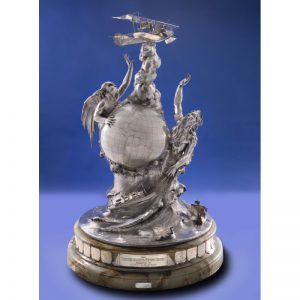Turns out Glenn Curtiss wasn’t the only early aviator to take off from Albany for points, well, not unknown, but a long way away, and it was Curtiss himself who inspired it. He had branched into both building airplanes and teaching pilots how to fly. He built on his ideas for enabling water landings (and takeoffs), developing marine airplanes, and to promote their use, he sponsored an annual competition for distance covered by a hydro-aeroplane. In 1915, a flyer named Beryl Kendrick drew national attention for his attempt to win the Curtiss marine flying trophy with a journey from Albany to Cape Hatteras, a trip he didn’t quite make.
 The competition was for the longest flight (which still allowed stops for refueling and mechanicals) in a flying boat in a single day between June 1 and Oct. 31, 1915, and would award a trophy. The trophy, by the way, sounds fabulous: “a flying boat of the transatlantic type which is shown in flight over the globe. The globe is supported on a base representing the sea. A figure of Neptune rises from the sea in an attempt to drag the boat down to its level and on the other side stands Boreas, ruler of the winds, who is blowing upon the boat in an effort to upset it. The trophy is done in silver and cost $5000.”
The competition was for the longest flight (which still allowed stops for refueling and mechanicals) in a flying boat in a single day between June 1 and Oct. 31, 1915, and would award a trophy. The trophy, by the way, sounds fabulous: “a flying boat of the transatlantic type which is shown in flight over the globe. The globe is supported on a base representing the sea. A figure of Neptune rises from the sea in an attempt to drag the boat down to its level and on the other side stands Boreas, ruler of the winds, who is blowing upon the boat in an effort to upset it. The trophy is done in silver and cost $5000.”
Kendrick was a wealthy young man from Atlantic City, who took an early interest in flying. He attended Curtiss’s flying school in San Diego in 1914-15, and bought a Curtiss flying boat and was licensed to fly it back in Atlantic City. His first attempt at the Curtiss trophy was a set of circuits from Atlantic City to Bay Head, NJ, but he was forced to land with engine trouble after 300 miles. Despite this, later in the year he redoubled his efforts and determined to make the trip from Albany to Cape Hatteras, NC. A typewritten biography of Kendrick, found on Flickr of all places, says:
“On October 28th Kendrick and [co-pilot Frank] Mills started again on a flight for the trophy from Albany, New York to Cape Hatteras, North Carolina, a distance of 750 miles. Their course was to be down the Hudson River and along the coasts of New Jersey, Delaware, Maryland, Virginia and North Carolina. They planned to stop twice for refueling, at Bay Head, New Jersey, and Ocean City, Maryland, and expected to make the flight within ten hours. They left Albany at 8:30 A.M. and all went well until about 11:00 A.M. when they landed at Edwin Gould’s Yacht Pier near New York City to tighten some wires. While there they refueled and as a result did not stop at Bay Head, which they passed at 1:00 P.M.
Flying conditions remained satisfactory until they reached the Delaware Capes where they began to encounter fog banks and serious trouble started. They pressed on and for two hours tried to extricate themselves from the intense fog by turning both seaward and to shore, and also by climbing to higher altitudes, to no avail. With their gas running low they were finally forced to land on the sea and await rescue. After fearing they might have to spend the night adrift the fog began to lift about 4:00 P.M. and a bit later they were able to see a fishing boat some two miles away. Using the last of their gas Kendrick taxied to the boat where he obtained some fuel. Leaving there they landed at Ocean City, Maryland at 5:30 P.M. after a total of 360 miles, thoughly [sic] soaked and quite exhausted from their misty exposure. Before they could make another try a bad hole was torn in the bottom of the hull forcing them to abandon the trophy event for the season. In spite of their misfortune Kendrick made a splendid flight and undoubtedly would have won the event if they had not encountered such extremely bad flying conditions.”
Kendrick’s flight was pretty widely reported. News reports datelined from Ocean City said Kendrick made stops at Poughkeepsie, Dobbs Ferry, and Atlantic Highland before he lost his way in a dense fog and “when overtaken by darkness was obliged to land in Assawoman Bay.”
Glenn Curtiss was unusual among aviation pioneers; while he did die relatively young, at 52, he died of appendicitis. That’s not how aviation pioneers usually went. Kendrick, who continued to fly passengers around the Atlantic coast of New Jersey as a sort of charter service, was more consistent with the normal trend of the time. He was killed in a crash in Atlantic City in 1919, at age 27. “Kendrick evidently lost control while engaged in some flying antics at a low altitude and crashed in the surf while reportedly vainly trying to make a landing, in plain view of crowds of boardwalk sight-seers.”
